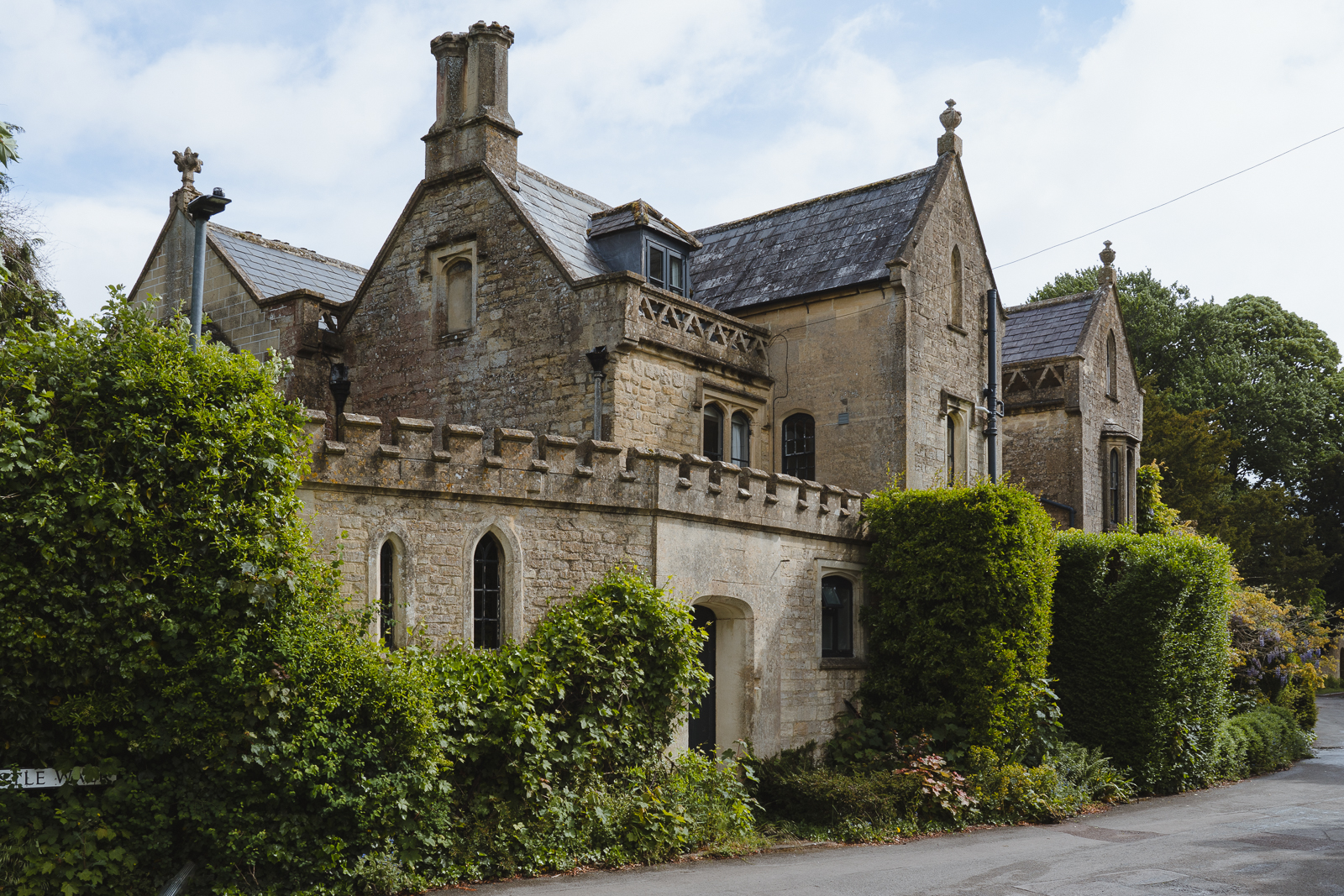The Grand Tour
Set discreetly behind wide wooden gates, the driveway is laid with pea gravel and has plentiful parking space for several cars. The stonework of the exterior of the house features beautifully mature wisteria, roses and climbing hydrangeas at its different elevations. Entrance is to the generous flagstone porch and dramatic entrance hall, where the cantilever stone staircase rises at its centre. The domed ceiling features strapwork plaster detailing and an elegant cornice. The study is set to the left of the hall, with one of the house’s many canted bay windows opening to a verdant and open aspect. The remainder of the ground floor unfolds on a wonderful circular plan, with each room leading to the other effortlessly. The principal rooms all feature open fireplaces, and all windows house original panelled shutters.
The drawing room is situated to the west of the plan, while the cosy sitting room is to the east. The kitchen is conveniently located centrally, featuring beautiful forest green-painted kitchen cabinetry, with reclaimed planes of oak resting atop; elm boards run underfoot. The kitchen opens to the glorious orangery, which makes for a capacious dining room and comfortably sits fourteen for dinner. This leads to a secluded exterior terrace, where the wisteria winds its way around the structure. There is also a secondary service kitchen, a generous utility room and a separate boot room with a shower room also conveniently located on this floor.
The first floor is home to the main suite of bedrooms and bathrooms. One of the bedrooms is currently configured as a dressing room and another as a second study. The principal bedroom is a lovely room, painted plaster-pink with a generous en suite shower room encased with limestone tiles. It is quite separate from the eastern range of the house, which features two bedrooms connected by a Jack and Jill shower room. A further set of bedrooms are at the house’s southern range, while back stairs lead to the apex of the house and three additional interconnecting rooms and a bathroom. This floor is particularly charming, with elm boards running underfoot through the entire floor and exposed beams lending great character to the rooms. These rooms would be ideal for staff quarters, or as currently used, for overflow bedchambers.
Separately, the house’s cellars are exceptionally well-designed and spacious. Accessed by descending a stone staircase discretely set behind a doorway in the kitchen, a long brick-paved hallway leads to a series of rooms with excellent ceiling heights. This floor features an open well, currently used for watering the gardens in high summer.
The Great Outdoors
The wonderfully mature gardens envelop the house creating a feeling of privacy and seclusion. Latticework fencing and yew hedges surround the perimeter with a canopy of Catalpa trees set above. Mainly laid with a verdant lawn, flower beds contain a mix of evergreen shrubs, including Buxus balls, ferns, and chic white hydrangeas and roses. There is an abundance of white, purple, and pink perennials that flower throughout spring and late summer. The gardens also have established plum and pear trees.
A hedge of tall bamboo reeds forms a palisade between the cottage and the main house, allowing for a degree of privacy and separation. The cottage is formed of two one-bedroom, self-contained apartments. Both share a private entrance pathway from Castle Street to the exterior of the house.
For further adventures in the natural world, Castlefields is situated on the very edge of Castlefields Park, where the river Marden winds through the bucolic countryside park reaching as far as Chippenham. A narrow plateau of high land to the west of Calne town centre, it is named after a prior castle that presided here in the 12th century. A separate cycle path (part of the Sustrans National Cycle Network) reaches as far as Bath, following along the line of the old Calne railway route.
Out and About
Calne town centre has a brilliant selection of amenities, including plentiful independent provisors; a favourite local coffee shop is the
Divine on the Green café. Nearby pubs
The White Horse, and acclaimed fish restaurant
The George & Dragon in Rowde are also recommended. The very popular town of Devizes is also nearby and has a wonderful farmer’s market on Thursday mornings. It also has an excellent butcher and artisan bakery, while the larger town of Marlborough has a vibrant High Street with plentiful independent shops, restaurants and cafes, and a large branch of Waitrose.
Lacock and Corsham are similarly favoured nearby towns, while slightly further afield are Tetbury for antique hunting and
Westonbirt National Arboretum to sample the delights of the natural world. Nearer to home is
Bowood House and Gardens, the perfect place to while away an entire day with plentiful distractions for children and adults alike.
The selection of nearby schools is excellent, for both state and independent. There are several local state primary schools within walking distance, as well as the very good Kingsbury Green Academy, catering for ages 11-18. A further choice of three senior state schools is in Chippenham, a 15-minute drive away. Independent schools nearby include St Margaret’s Preparatory School, while St Mary’s Calne offers both day and boarding at secondary level; both are within a short walk from Castlefields. Dauntsey’s School in West Lavington is slightly further afield, which offers both day and boarding. Marlborough College is also nearby, in addition to the plentiful choice of further schools in Bath.
Fast and half-hourly rail services to London Paddington are available from Chippenham rail station, just a 15-minute drive away, with journey times taking 68 minutes precisely. Bath and Bristol journey times in the opposite direction are just 10 and 15 minutes, respectively. Bristol International Airport is approximately 40 miles west and just over an hour’s drive away. The M4 is around 10 miles to the north for fast routes to London and Bristol, where the M5 can be joined for the Southwest.
Council Tax Band: G
